Final Exam Review PDF

| Title | Final Exam Review |
|---|---|
| Author | Luisa De Luca |
| Course | Forensic Science |
| Institution | Fairleigh Dickinson University |
| Pages | 12 |
| File Size | 120.2 KB |
| File Type | |
| Total Downloads | 50 |
| Total Views | 141 |
Summary
FINAL EXAM REVIEW for the final exam in the course Crime and Forensics taught by Professor Forsthoff. ...
Description
Crime & Forensics Final Exam Review ● Crime Scene ○ The area where a crime may have occurred. The area is established by the investigator in charge, but must encompass the crime-related activities. ● Crime ○ An offense against the public at large, proclaimed in a law, and punishable by an official governing body. ● Forensic(s) ○ Pertaining to, connected with, or used in courts of law or public discussion and debate. ○ Adapted or suited to argumentation; rhetorical. ○ The art or study or argumentation and formal debate. ● Forensic Science ○ A discipline compromised of a diverse group of forensic professionals who employ and adhere to the rigorous standards of their respective professions, who consider matters under consideration in order to ascertain the truth of a set of alleged facts, criminal or civil. ● Evidence ○ Anything offered in court to prove the truth or falsify of a fact in issue. ● Crime Scene Investigation (CSI) ○ The beginning point for the successful use of physical evidence by the forensic laboratory and the criminal investigator. ● Investigation Process ○ Recognition ■ Scene survey - “walk through” ■ Documentation - notes, photos, sketches, videos. ■ Collection and Preservation of Physical Evidence - systematic “scene search” ○ Identification ■ Comparison testing. ○ Individualization ■ Evaluation and interpretation. ○ Reconstruction ■ (determining/eliminating events) ■ Reporting and presentation. ● Pictorial Documentation ○ One of the investigator’s most important jobs at the crime scene is to create an accurate, objective, visual record of the crime scene before any items or objects are moved or removed as possible elements of evidence. ○ Photos of the scene of a serious criminal act should be taken as soon as possible after preliminary investigative priorities have been taken care of, and before note taking, sketching, or a search for evidence begins.
● ●
●
●
●
●
● ● ●
●
●
●
● ●
Evidence ○ Anything offered in court to prove the truth or falsity of a fact in issue. The Forensic Mind ○ If a man will begin with certainties, he shall end in doubts; but if he will be content to begin with doubts, he shall end in certainties. Evidence Types ○ Testimonial ○ Real or physical ○ Demonstrative ○ Documentary ○ Direct ○ Circumstantial Testimonial ○ Spoken evidence concerning facts personally observed or experienced by witnesses sworn to testify. Real or Physical ○ Tangible objects in their original state. To show fact about them which is relevant to an issue in the case. Demonstrative ○ Photographs, diagrams, maps, to show or help illustrate some fact which is relevant. Documentary ○ Written evidence. Direct ○ Evidence directly perceived by the five senses. Circumstantial ○ Evidence based on an interference we make as to the existence of unobserved fact from our knowledge of the existence of certain other facts that have been proved. Rule of Evidence ○ Rules of court that govern the admissibility of evidence at trials and hearings. ○ Exclusionary rule ○ Relevancy (materiality) ○ Competency Exclusionary Rule ○ Evidence that has been obtained in violation of constitutional guarantees against unlawful search and seizure must be excluded at trial. Relevancy (Materiality) ○ The applicability of evidence in determining the truth or falsity of the issue being tried. Competency ○ The quality of a piece of evidence and/or a person offering evidence. Physical Evidence
Anything detectable by sensory, physical, chemical, optical or electronic means, including those things in a digital or multimedia form, that provide factual information about a crime. What can Physical Evidence Reveal? ○ Corpus Delecti - B ody of the Crime. ○ Modus Operandi - M ethod of Operation. ○ Linking Of: s uspect with victim; person to crime scene. ○ Disproving/Supporting t estimony ○ Identification o f suspect(s) ○ Providing I nvestigative Leads Physical Evidence Collection ○ The entire success of a criminalistic operation, as it is concerned with physical evidence, depends on: ■ Receiving all relevant evidence ■ Proper condition of evidence for examination ■ Establish origin and chain of possession (custody) of evidence. Chain of Custody ○ Proof of possession of evidence from the moment it is found until the moment it is offered as evidence. Physical Evidence Preservation Procedure: ○ Recognize relevant physical evidence. ○ Determine that it can be tested in a lab. ○ Collect with care and diligence. ○ Handle, package and label properly. ○ Record recovery; photographs, sketch, notes. ○ Chain-of-custody; scene to lab to court. ○ Present or explain in court. Physical Evidence Characteristics ○ Class Characteristics ○ Individual Characteristics Class Characteristics ○ Describe the physical object and limit the likelihood that similar objects exist. Individual Characteristics ○ Those which make an object different from all others within its group, establishing the unique identity of an object to the exclusion of all others. ○ Fingerprints ○ Teeth marks ○ Firearms ○ Spent ammunition ○ Tools ○ Toolmarks ○ Typewriting ○ Shoe prints ○
●
●
●
●
●
● ●
●
●
●
●
●
○ Tire tracks ○ Handwriting ○ DNA typing. Individualization Principle ○ All objects in the universe are unique. ○ No two things that happen by chance ever happen in exactly the same way. ○ No two things are ever constructed of manufactured in exactly the same way. ○ No two things ever wear in exactly the same way. ○ No two things ever break in exactly the same way. Individualization ○ The individualization of an impressions [fingerprint, dental, shoe, bullets, handwriting, break/fracture] is established by finding agreement of corresponding individual characteristics by such number and significance as to preclude the possibility (or probability) of their having occurred by mere coincidence, and establishing that there are no differences that cannot be accounted for. Types of Physical Evidence ○ Weapons (guns, knives, clubs, cordage) ○ Tools (all marks made by them) ○ Projectiles (bullets, cartridges, shell cases) ○ Materials ( glass and paint fragments, bits of metal and plastic) ○ Prints (fingers, shoes, tires, tools) ○ Clothing (fibers, stains, contact traces) ○ Physiologicals ( blood, semen, saliva, other fluids, tissues, and hair.) ○ Blood and Tissue ( toxicological analysis) ○ Motor Vehicles (anything) ○ Fire Residues ( accelerant containers, debris) ○ Drugs (pills, capsules, tablets, powders, residues) ○ Questioned Documents (handwritings, handprinting, typewriting, printers, mechanical and thermographic reproductions, obliterations, inks, papers, folds.) ○ Digital ( computers, cell phones, thumb drives, MP-3’s, cameras, copiers, printers, any storage devices (cards), etc.) Stages of Analysis ○ Recognition ○ Documentation ( scene and evidence) ○ Collection and Packaging ○ Preservation ○ Analysis (identification, individualization, reconstruction) ○ Interpretation of Results ○ Reporting Results and Expert Testimony. Purpose of Crime Laboratory
To provide the investigator with answers to questions related to the identity of the evidence and how the evidence might relate to the elements of the crime and its predators. Forensic/Crime Laboratory ○ A laboratory, with at least one full-time scientist, which examines physical evidence in criminal matters and provides opinion testimony with respect to such physical evidence in a court of law. Operations of Crime Laboratory ○ Public and Private ○ Federal (FBI, ATF, DEA, USPS, USSS, USEPA) ○ State (NJSP Regional Laboratory System - North, East, Central, South) ○ Local (County: Hudson, Cape May, Union, Ocean) ○ Municipal (Newark) Crime Laboratory Role in Society ○ Responsibility to the police ■ Effective communications regarding case analysis of physical evidence with “integrity,” scientists must remain “objective” and not view themselves as instruments of the police. ○ Responsibility to the prosecution. ■ Quality and reliable analysis as an expert witness: an unbiased scientist beyond reproach - “Impartiality” ○ Responsibility to the victim. ■ Obligation to perform comprehensive analysis of evidence. ■ Must remain “object” and not align themselves too closely; can not overstate conclusions to assist with prosecution. ○ Responsibility to the suspect/defendant. ■ Identify the guilty … identify the innocent. ■ Obligation to provide results expeditiously. ○ Responsibility to society. Fingerprints (Friction Ridge Skin) ○ Hairless ○ Contains no sebaceous (oil) glands ○ Much higher concentration of nerve endings. ○ Much higher concentration of sweat glands. ○ Lacks pigmentation. ○ Exists only on palm side of hand and sole of feet. ○ Designed for grasping, holding and feeling. Fingerprints Residue ○ Skin Surface Residue (Eccrine, Sebaceous, Keratinizing, Epidermis, Apocrine) ○ Deposition (time, pressure, contact angle) ○ Donor (child, adult, gender, age, health, diet) ○ Substrate (porous, non-porous) ○ Containments (outside materials/chemicals) ○
●
●
●
●
●
●
●
● ●
●
●
●
●
●
●
●
○ Ambient Conditions & Time (light, temperature, moisture and humidity) Types of Evidentiary Fingerprints ○ Three types of fingerprints encountered at crime scenes or on evidence: ■ Patent ■ Plastic ■ Latent Patent Fingerprint ○ Clearly recognizable fingerprint that needs no processing - could be in grease, blood, dirt, or oil. Plastic Fingerprint ○ Also called an impression or indentation print - could be in tar, butter, silly putty. Latent Fingerprint ○ Requires additional processing to be rendered suitable for comparison - processing is called development or enhancement. General Fingerprint Patterns ○ Loops (60%, ulnar, radial) ○ Arches (5%, plain, tented) ○ Whorls (30%, plain, central pocket, double-loop, accidental) Fingerprints Comparison: A.C.E.-V ○ General Pattern Agreement ( class characteristic - loop, whorl, arch) ○ Qualitative Concordance (ridge characteristics - same type and shape) ○ Relationship of Ridge Characteristics (various details must stand in same relationship) ○ Quantitative Factors (number of points (minutiae) shared by two impressions) A.C.E.-V ○ Analysis ○ Comparison ○ Evaluation ○ Verification Fingerprint Analysis ○ The qualitative and quantitative assessment of level 1 (pattern), level 2 (ridge characteristics), level 3 (pore characteristics, scars, edgoscopy for example. Details to determine their proportion, interrelationship and value to individualize. Fingerprint Comparison ○ To examine the attributes observed during analysis in order to determine agreement or discrepancies between two friction ridge impressions. Fingerprint Evaluation ○ The cyclical procedure of comparison between two friction ridge impressions to effect a decision. Fingerprint Verification ○ An independent analysis, comparison, and evaluation by a second qualified examiner of the friction ridge impressions.
●
●
●
● ●
● ● ●
●
● ●
●
Major Ridge Patterns ○ Major ridge path formations are sometimes referred to as: ■ Ridge Endings - r idges that end abruptly ■ Bifurcations - R idges that appear to split apart and continue on as two ridges ■ Enclosures - Ridges that appear to split in two and then rejoin. ■ Short Ridges - C onsist of at least two ridge units. ■ Ridge Dots - o nly one ridge unit. Fingerprint Development Methods ○ Physical - p owders - various colors; technical; inked - Live and Dead. ○ Chemicals - I odine fuming (reacts w/fats & oils); Ninhydrin (reacts w/ amino acids); Silver Nitrate (reacts w/ salts); Cyanoacrylate ‘Super Glue’ vapors. ○ Light - L ASER, U.V., Alternate Light Source. Firearms Identification ○ A discipline of forensic science which has as its primary concern to determine if a bullet, cartridge case or other ammunition component was fired by a particular firearm. Ballistics ○ The study of the motion of a projectile. Rifles ○ A firearm with a rifled barrel, designed for use with two arms and fired from the shoulder. Shotguns ○ A shoulder fired smooth-bored firearm. Handguns ○ A short firearm with a rifled barrel intended to be aimed and fired with one hand. Semi-automatic Pistol ○ A self-loading handgun which fires, ejects the empty cartridge case, reloads and cocks itself each time the trigger is pulled. Revolver ○ Repeating handgun with a revolving cylinder chambered to hold cartridges, can be single or double action. Derringer ○ Small, easily concealed handgun, with 1-4 barrels each firing a single shot. Range Determination ○ Distant Shot - s hot fired from such a distance that no gunshot residue reached the target surface. ○ Close-range Shot - s hot fired close enough for some gunshot residue to reach target surface. ○ Near-Contact Shot - s hot fired a range of 1” or less. ○ Contact Shot - s hot was fired with the muzzle in contact with the target surface. ■ Loose contact - j ust touches surface, gases may escape. ■ Hard contact - p ressed tightly, gases follow bullet. Firearm Lab Examination
●
●
●
●
● ●
● ●
●
●
●
○ Identify and compare fired bullets and cartridges ○ Examine powder and shotgun pellet patterns. ○ Restore obliterated serial numbers. ○ Conduct toolmark examinations. Firearms Examiner Conclusions ○ Positive Identification - t he questioned firearm fired the questioned bullets and/or cartridges. ○ Negative Identification - t he questioned firearm did not fire the questioned bullet and/or cartridges. ○ Inconclusive - t he questioned firearm could have fired the questioned bullets and/or cartridges. Trace Evidence ○ Physical evidence that results from the transfer of small quantities of material - hair, textile fibers, paint chips, glass fragments, gunshot residue particles. Fiber Type ○ Animal Hairs - p resence of scales: wool, goat, silk, camel, llama, rabbit, cow. ○ Plant Fibers - s eed, bast, leaf, fruit, cotton. ○ Mineral - g lass, wool, asbestos. ○ Man-Made Fibers - r egenerated and synthetic: acrylics, nylons, polyesters. Class Characteristics ○ Density - mass/volume. ○ Refractive Index - difference, or ratio of velocity of light in a vacuum and its velocity through glass determines degree of refraction. Individual Characteristics ○ Broken pieces, glass fracturing. Internal Computer Crimes ○ Alterations to computer programs that result in the performance of unauthorized functions within a computer program. Telecommunications Crimes ○ Illegal access to or use of computer systems over telephone lines. Computer Manipulation Crimes ○ Changing data or creating records in a system for the advancement of another crime, usually theft related. Support of Criminal Enterprises ○ Data bases to support - drug distributions, records of client transactions, money laundering. Hardware and Software Thefts ○ Thefts of computers, microprocessor chips, trade secrets, witnessed software piracy. Cyberspace Online Crimes ○ Committed in the world of online computer communications - World Wide Web (WWW), Usernet, Newsgroups, Internet Relay Chat rooms and Electronic Mail (E-mail).
● ● ●
● ● ●
●
●
● ● ● ●
●
Document ○ Any fixed method of communication between one individual and another. Questioned Document ○ One that in its entirety or in part is suspect as to authenticity or origin. Forged ○ Documents that are altered originals produced by adding, removing or substituting relevant information or features. Counterfeit ○ Documents that are reproduced as originals. Sources of DNA ○ Blood (white blood cells), tissue, hair root, urine, semen, bone, saliva, tooth pulp. DNA Typing Systems ○ RFLP (Restriction Fragment Length Polymorphism) ■ Determines variation in the length of a defined DNA fragment; requires more and better quality DNA. ○ PCR (Poulmerase Chain Reaction) ■ A general technique for increasing the amount of a specific section of DNA in the sample, DNA amplification; results may be obtained for a sample of limited quality and quantity. Semen ○ A semi-fluid heterogeneous gelatinous mass; produced by post-pubescent males and ejaculated following sexual stimulation. Saliva ○ A slightly alkaline secretion found in the mouth. Its primary purpose is to aid in the initial stages of digestion by lubricating food masses for easier swallowing and initiating the digestion of starches using the enzyme amylase. Passive Stains ○ Move only under the influence of gravity. Spatter Stains ○ Arise from a force in addition to gravity. Altered Stains ○ Physically or physiologically changed. Forensic Pathology ○ Involves the examination of living and dead people and the analysis of biological and physical substances in order to provide opinions concerning: ■ The cause, mechanism, effects, and manner of injury, illness or death. ■ The identification of people. ■ The nature and significance of biological and physical evidence. ■ The correlation and/or reconstruction of wounds. ■ Patterns, and sequences. ■ Investigating and documenting the mechanisms of disease and injury. Medicolegal Death Investigation ○ Scene of death investigation.
●
● ●
●
●
●
●
●
●
○ Witness gathering. ○ Documentary evidence - social, psychiatric, medical history of deceased. ○ Postmortem examination and autopsy. ○ Report. Role in Forensic Death Investigation ○ Ascertain that death has occurred. ○ Establish identity of deceased. ○ Identify place of injury and place of death. ○ Estimate time since death. ○ Establish whether body has been moved since death. ○ Obtain evidence from body that may be lost or will deteriorate during transport. ○ Formulate sequence of fatal events and surrounding circumstances. ○ Establish diagnosis of apparent cause and manner of death. Cause of Death ○ The injury or disease which initiates the chain of events leading to death. Mechanism of Death ○ The biochemical or physiologic abnormality produced by the cause of death which is incompatible with life. Manners of Death ○ Natural - d eath resulting from the inevitable failure of a vital body function due solely to a natural disease process. ○ Accidental - d eath due to trauma but the trauma was not intentionally applied to the body. ○ Suicidal - d eath due to trauma which is intentionally self-induced. ○ Homicidal - a third party intentionally causes the injuries leading to death - not necessarily unlawful. ○ Undetermined - i ndicators that are so equivocal. Toxicology ○ The study of poisons (toxins or toxicants) that can cause impairment, poort health, or death. Forensic Toxicologist ○ Concerned with the recognition, study, and evaluation of foreign chemicals by the analysis of body fluids, tissues, organs, and materials originating from living organisms. Postmortem ○ To determine whether alcohol, drugs or other poisons may have caused or contributed to the death of a person. Human Performance Testing ○ Deals primarily with driving under the influence of drugs and alcohol, can also be referred to as behavioral toxicology dealing with an inability to per...
Similar Free PDFs

Chem Final Exam Review
- 12 Pages

Final Exam - Review notes
- 92 Pages

Bio Final Exam Review
- 2 Pages

Final EXAM Review booklet
- 5 Pages
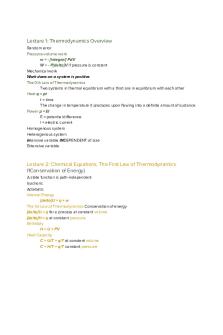
CHEM303 final exam review
- 4 Pages

Psychology Final Exam - Review
- 13 Pages
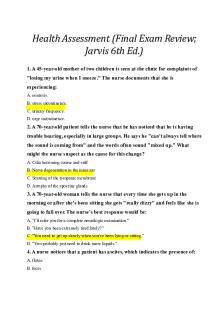
Jarvis Final Exam Review
- 12 Pages
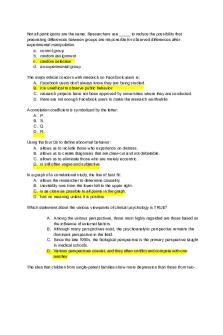
Final exam review
- 96 Pages
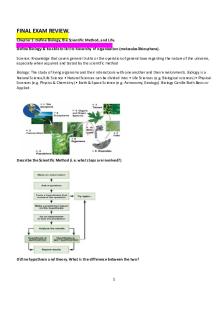
Final Exam Review
- 48 Pages
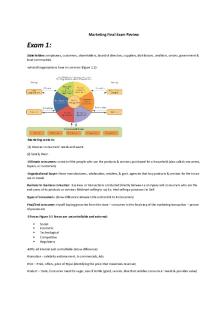
Marketing Final Exam Review
- 15 Pages
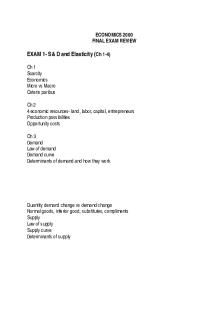
Final exam review
- 8 Pages
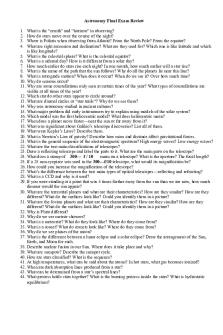
Astronomy Final Exam Review
- 2 Pages
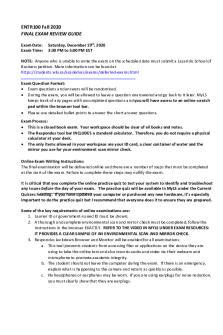
Final Exam Review Guide
- 4 Pages

Final exam review flsp4420
- 5 Pages

Theo Final Exam Review
- 16 Pages

Entrepreneurship final exam review
- 33 Pages
Popular Institutions
- Tinajero National High School - Annex
- Politeknik Caltex Riau
- Yokohama City University
- SGT University
- University of Al-Qadisiyah
- Divine Word College of Vigan
- Techniek College Rotterdam
- Universidade de Santiago
- Universiti Teknologi MARA Cawangan Johor Kampus Pasir Gudang
- Poltekkes Kemenkes Yogyakarta
- Baguio City National High School
- Colegio san marcos
- preparatoria uno
- Centro de Bachillerato Tecnológico Industrial y de Servicios No. 107
- Dalian Maritime University
- Quang Trung Secondary School
- Colegio Tecnológico en Informática
- Corporación Regional de Educación Superior
- Grupo CEDVA
- Dar Al Uloom University
- Centro de Estudios Preuniversitarios de la Universidad Nacional de Ingeniería
- 上智大学
- Aakash International School, Nuna Majara
- San Felipe Neri Catholic School
- Kang Chiao International School - New Taipei City
- Misamis Occidental National High School
- Institución Educativa Escuela Normal Juan Ladrilleros
- Kolehiyo ng Pantukan
- Batanes State College
- Instituto Continental
- Sekolah Menengah Kejuruan Kesehatan Kaltara (Tarakan)
- Colegio de La Inmaculada Concepcion - Cebu